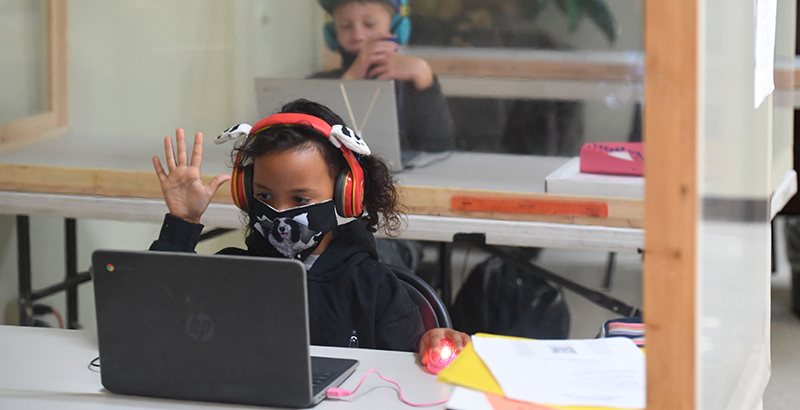Manno: Parents, Civic Entrepreneurs Rebuild K-12 Schooling from Scratch in a Way That’s Student-Focused, Parent-Directed and Pluralistic

Get stories like this delivered straight to your inbox. Sign up for The 74 Newsletter
“Never in my lifetime have so many parents been so eager for so much education change.”
So said longtime pollster Frank Luntz after surveying 1,000 public and private school parents on how the pandemic affected their view of schools.
COVID-19 forced schools to change from being buildings where teaching, learning and programs were bundled together to serve students and families to a menu of services and choices that parents were forced to piece together — rebundle — to meet their needs.
The potential long-term result could be a more student-focused, parent-directed and pluralistic K-12 school system.
The consulting firm Tyton Partners estimates COVID-19 shock produced a 2.6 million-student decrease in district and private schools, with charter schools, homeschooling, microschools and other alternatives gaining enrollment. The U.S. Census reports homeschooling enrollment increased from 5.4 to 11.1 percent of households. African Americans registered a fivefold increase, from 3.3 to 16.1 percent.
What other alternatives did parents choose as they worked to rebuild their child’s schooling?
One was family-organized discovery sites, aka pods — gathering small groups of students, in person or virtually, with added services like tutoring, child care or afterschool programs. San Francisco Mayor London Breed opened 84 pods serving around 2,400 children, about 96 percent racial minorities. The Columbus, Ohio, YMCA offered pods for students aged 5 to 16 attending schools virtually, with arrival as early as 6 a.m. JPMorgan Chase offered discounts on virtual tutors and pods for eligible employees using Bright Horizons, its employer provider, and opened its 14 child care centers for employees’ children’s remote learning at no cost. Organizations like SchoolHouse, LearningPodsHub and Selected for Families helped parents start pods, organizing teachers and tutors.
Microschools were another alternative. They reinvent the one-room schoolhouse, enroll 15 students or less and employ one teacher. Or, parents teach, hiring a college student or other “grown-up” to assist. Prenda, an Arizona microschool network, expanded to Colorado during the pandemic, growing from seven students in 2018 to over 400 schools and 3,000 students who meet in homes or public spaces like libraries. That growth created new partnerships, like the one with Black Mothers Forum, in which Prenda provides the education program and training and the forum provides the school location, student meals through community partnerships, before- and after-school care, and other services.
Virtual schools are a third alternative. Florida Virtual School, an accredited, online, tuition-free school founded in 1997, had over 231,100 new course enrollments — up 57 percent — in its part-time Flex program.
Many parents want to continue to use virtual learning for at least some part of their children’s schooling. An NPR/Ipsos poll found 29 percent likely to stick with remote learning indefinitely, including about half now using virtual learning.
Policymakers can do two things to assist families wanting to continue their new schooling options and to open them to more parents.
First, elected officials can expand or create programs providing financial assistance. Lawmakers in nearly a third of the states have proposed new laws to expand or establish taxpayer-funded programs like education savings accounts to support these approaches. And governors are using federal COVID-19 relief funds in inventive ways. For example, Idaho Gov. Brad Little created a $50 million Strong Families, Strong Students Initiative, giving eligible families $1,500 per student, with a maximum of $3,500, for educational materials and services.
Second, school district leaders and state officials can continue or expand programs created during the pandemic. A RAND Corp. survey of more than 375 school districts and charter management organizations found 1 in 5 considering a remote school option post-pandemic, including districts in Los Angeles, Las Vegas, Miami and Houston.
On the other hand, New York City and the state of New Jersey announced that remote learning won’t be available for fall 2021.
This led RiShawn Biddle, editor of Dropout Nation, to write in The New York Times that as a “Black man [he believes this is] bad news for the majority of the country’s Black, Latino and Asian students and their parents [that] exacerbates already-existing educational and health care inequities.”
COVID-19 threw into disarray the longstanding relationship between home and school. It created an experiment in K-12 schooling that catalyzed creative and determined parents, civic innovators and policy leaders to respond in new ways. The budding result is a more student-focused, parent-directed, pluralistic K-12 system that federal, state and local policymakers should continue to support.
Bruno V. Manno is senior adviser to the Walton Family Foundation’s K-12 Program. The foundation provides financial support to The 74 and to some of the organizations named in this essay.
Get stories like these delivered straight to your inbox. Sign up for The 74 Newsletter

;)
